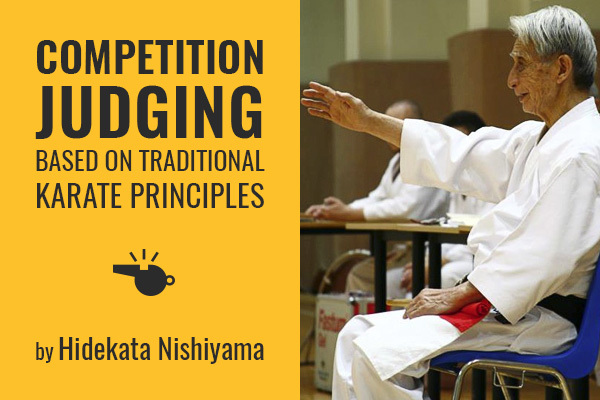Competition Judging Based on Traditional Karate Principles
Hidetaka NISHIYAMA / ITKF - 2002

In documentul prezentat, Jurizarea Competitiilor de Karate bazata pe principii de Karate Traditional - "COMPETITION JUDGING BASED ON TRADITIONAL KARATE PRINCIPLES, de Hidetaka NISHIYAMA" publicat in 2002, am pastrat limba originala in care a fost publicat documentul pentru a transmite cat mai corect nuantele si intelesul acestuia.
COMPETITION JUDGING BASED ON TRADITIONAL KARATE PRINCIPLES
Hidetaka NISHIYAMA / ITKF - 2002
SUMMARY:
I. KEY POINTS FOR KUMITE JUDGING
Maintain sense of two competitors simultaneously-Keep eyes in TOYAMA no MATSUKE state of awareness-in order to see actions of both competitors -as if participating with athletes.
The judge also maintains breathing state ready at any moment for KIAI, thus keeping synchronized with competitors.
When competitors initiate their movements, react with them with your own body thus staying in tune with them.
The judge follows the action with both eye and breathing and thus prepared for KIAI just as athletes are prepared to KIAI.
Pay close attention to competitors' feet as they make strong pressure to floor without "bouncing”.
At the moment at detecting a competitor's initiation of techniques (maximum pressure to floor), the judge exhales and makes sound (like all “HAII”) at same time thrusting arm to begin indication of score or no score depending on outcome of the competitors technique. At same time, the judge takes a mental photograph of the competition action by which to make his final decision relative to scoring.
Review this image as a means of judging and scoring.
Note:
Proper reaction of floor pressure at final stage of technique is the only way to produce TODOME and true KIME power and thus, a scoring point.
If no correct floor pressure, then KIME and TODOME is impossible to achieve.
At this moment, while the arm is moving, decide if score or not, then continue with "yes" or "no" arm signal.
Remark: After initial arm motion, make the judging decision in a split second if possible. If not, a little late is okay because proper review and accurate judging is most important.
Correct or incorrect posture:
Body axis maintained perpendicular (straight) to floor
Correct or Incorrect Stance
Capable of applying maximum pressure to floor
Capable of resisting shock of contact
Maintaining eye contact-correct or incorrect
Correct or incorrect breathing
Proper control of exhalation and inhalation to control technique
Degree of KI power/energy charge
Body Dynamics
Degree of increased energy to direction of technique
Body parts move from center of joints without moving out of alignment
Degree of correctness of timing of body movement moving up from floor through body parts to target
Degree of increased energy
remark: Energy is increased as a function of increasing acceleration
Degree of quick increase of energy at final stage of technique
remark: In case of hand techniques, energy is increased by a factor of four when linear movement is correctly changed to rotary action
Power
Degree of total pressure to floor at final stage of body movement
Degree of total energy transmitted to target from pressure to floor through body movement
Degree of total body muscle contraction toward target
remark: In case of shocking power, total muscular an sudden contraction is necessary
Form
Degree of following proper course for application o technique-no unnecessary actions or deviations from line of movement
Degree of proper final position at end of technique
Degree of maintaining proper center line position during both defense and offense
gree of maintaining proper line of eye contact to opponent
Degree of accurate target positioning eg... JODAN and CHUDAN
Degree of KIME / ZANSHIN for every movement
Transition
Body Shifting
Degree of keeping body weight centered and maintaining control of feet by the body (Keeping balance without moving body center up and down)
Continuation
Degree of using contraction/reaction power to maintain smooth continuation of technique (maximum contraction/reaction then used to initiate next technique)
Degree of maintaining momentum without interruption of flow of energy/power (smoothness of continuation of techniques). This smooth transmission of momentum is to be maintained from the beginning of the kata to its very ending
Tempo
Degree of correct matching of timing to application of Technique
Mastering
Degree of accuracy of technique and body movement
Degree of quality of techniques is the result of a long period of training
Impression
Degree of impression perceived of outward expression of inner body dynamics.
Finalul documentului: COMPETITION JUDGING BASED ON TRADITIONAL KARATE PRINCIPLES by: Hidetaka NISHIYAMA / ITKF - 2002.
Alege clubul cu care dorești să intri în contact sau discută direct cu Federația Română de Karate Tradițional.
Înscrie-ți clubul pe Harta Karate-ului Tradițional din România. Clubul trebuie să fie acreditat și afiliat FRKT/ETFK/ITKF.
Trimite-ne un eveniment, antrenament sau articol despre Karate Tradițional și noi îl vom publica.
Dacă ai nevoie de ajutor nu ezita să ne contactezi.